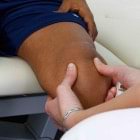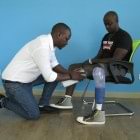Gait training with a leg prosthesis

Become fit for your everyday life again
The goal of rehabilitation is to optimally prepare you for life with your prosthesis. On the one hand, this includes regaining strength, endurance and coordination through targeted physiotherapy. On the other hand, specialised gait training teaches you how to use your prosthesis.
In gait training for transfemoral amputees, the basic functioning of the knee joint also plays a major role. Ideally, the training and education programme is therefore tailored to the prosthesis components being used. The programme should be aimed at relearning everyday motion sequences and explaining the functionality of your prosthesis to you.
Learn here about what gait training for leg amputees involves.
Rehabilitation after the leg amputation
Prosthetic fitting information
Putting on and taking off the prosthesis correctly
Putting on and taking off the prosthesis correctly by yourself: That is the basis for walking with a prosthesis, which you will practice first. Your family may have to help you at first. So it is important to also include them in rehabilitation. However, the goal is for you to learn how to do this independently with some practice. There are various ways to put on a prosthesis, depending on the type of prosthesis and the characteristics of your residual limb. Your therapist or O&P professional will show you the best method for you.

How to put on a below knee prosthesis with one-way valve and knee sleeve?

How to put on an above knee prosthesis with Pin Liner (Shuttle Lock System)?
Sitting down and standing up with a prosthesis
Once you know how to put on the prosthesis and take it off, sitting down and standing up are the next everyday actions you will learn. Users with a transfemoral amputation fitted with a knee joint with sitting assistance can put weight on both legs while sitting down. The Prosedo, Kenevo, C-Leg® 4, Genium or Genium X3 from Ottobock have this function, for example. This results in significant relief for the sound side, which helps prevent premature problems from excessive strain. Users with a transtibial amputation should also put the same amount of weight on both legs when sitting down and standing up for the same reason.
Walking on level surfaces
Once you are generally confident in handling the prosthesis, actual gait training can begin. Improving balance and coordination, sufficient weight bearing on the prosthesis side and straightening the pelvis and upper body are the objectives. Your therapist also continues to work on strengthening your muscles, because strong muscles are essential for a stable body posture while walking.
First you learn how to shift your body weight and stand on one leg between parallel bars. Do not support all your weight with your arms and sound leg; use your prosthesis too. As soon as you can walk between parallel bars, you start the first exercises without support. The first objective is to gradually reduce the use of any walking aids you may require initially. This is achieved through a combination of correct walking technique and strengthening the torso musculature. All gait exercises are monitored by your therapist to ensure that no gait deviations creep in. At first, the therapist is always by your side, offering help. But over time you will no longer need such assistance.
Once you have mastered walking on level ground, you will also practice walking on various other surfaces.
Walking safely on stairs and ramps
You will always encounter obstacles in daily life, such as curbs, stairs in the home or a ramp leading up to the garage. Walking safely on stairs and ramps is a constant part of your daily life, and is practiced with you during gait training. The individual components of your prosthesis determine what walking technique is right for you.

